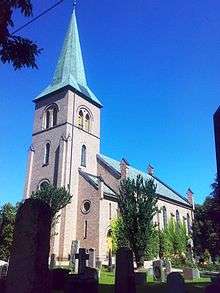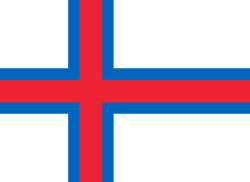Asker
| Asker kommune | |||
|---|---|---|---|
| Municipality | |||
|
| |||
| |||
 Asker within Akershus | |||
| Coordinates: 59°50′7″N 10°26′6″E / 59.83528°N 10.43500°ECoordinates: 59°50′7″N 10°26′6″E / 59.83528°N 10.43500°E | |||
| Country | Norway | ||
| County | Akershus | ||
| District | Viken, Norway | ||
| Administrative centre | Asker | ||
| Government | |||
| • Mayor (2007) | Lene Conradi (H) | ||
| Area | |||
| • Total | 101 km2 (39 sq mi) | ||
| • Land | 97 km2 (37 sq mi) | ||
| Area rank | #385 in Norway | ||
| Population (2014) | |||
| • Total | 59,037 | ||
| • Rank | #11 in Norway | ||
| • Density | 585/km2 (1,520/sq mi) | ||
| • Change (10 years) | 15.7% | ||
| Demonym(s) | Askerbøring[1] | ||
| Time zone | UTC+01:00 (CET) | ||
| • Summer (DST) | UTC+02:00 (CEST) | ||
| ISO 3166 code | NO-0220 | ||
| Official language form | Bokmål | ||
| Website |
www | ||
| Historical population | ||
|---|---|---|
| Year | Pop. | ±% |
| 1951 | 13,625 | — |
| 1961 | 17,755 | +30.3% |
| 1971 | 31,702 | +78.6% |
| 1981 | 35,977 | +13.5% |
| 1991 | 41,903 | +16.5% |
| 2001 | 49,661 | +18.5% |
| 2011 | 55,284 | +11.3% |
| 2014 | 59,037 | +6.8% |
| 2021? | 63,381 | +7.4% |
| 2031? | 69,296 | +9.3% |
| Source: Statistics Norway.[2] | ||
Asker is a municipality in Akershus county, Norway. It is part of the Greater Oslo Region. The administrative centre of the municipality is the town of Asker. The municipality was established as a municipality on 1 January 1838 (see formannskapsdistrikt).
Introduction
Name
The municipality (originally the parish) is named after the old Asker farm, since the first church was built here. The name (Old Norse: Askar) is the plural form of ask which means "ash tree".
Coat-of-arms
The coat-of-arms is from modern times. They were granted on 7 October 1975. The arms show a green background with three silver-colored tree trunks (Norwegian: askekaller) and are thus canting arms. The trees are ashes, which were cropped every year to provide food for the animals. The trees thus developed after many years a very typical shape, which was characteristic for the area.[3][4]
Place of the Millennium
In 1998, just before the millennium, the 'Askerbøringer' (the inhabitants of Asker) elected the beautiful area of Semsvannet including the mountain ridge Skaugumsåsen – to be their Place of the Millennium.
Geography
Its main parts are Asker, Gullhella, Vollen, Vettre, Blakstad, Bleiker, Borgen, Drengsrud, Dikemark, Vardåsen, Engelsrud, Holmen, Høn, Hvalstad, Billingstad, Nesøya, Nesbru, and Heggedal. Asker is a coastal place with many beaches, but also contains hills and woods. The district is known for many important businesses. It is also known for gardening. The Skaugum estate, where Crown Prince Haakon of Norway lives with his family, is situated here. The first IKEA store outside of Sweden opened at Slependen in Asker in 1963. There are many hiking/ sightseeing spots around Asker; such as Semsvannet lake[5] and Drengsrud cultural path[6] around the area.
Municipality Reform
As part of the municipality reform process instigated by Minister of Local Government Jan Tore Sanner the municipalities of Asker, Hurum and Røyken evaluated if they should merge into a new common municipality during the first half of 2016. A tentative agreement was reached and on 16 June 2016 the Municipal Council of Røyken approved the merger with Asker and Hurum with 24 votes for and 3 against.[7] On 14 June 2016 the Municipal Council of Asker also approved the merger with 42 votes for and 5 against.[8] A few days later the Municipal Council of Hurum followed suit and approved the merger. The proposed merger date is 1 January 2020 and the new name will be Asker.[7] The administrative center will still be Asker.
Ethnic and foreign minority
| Ancestry | Number |
|---|---|
| 1,870 | |
| 846 | |
| 562 | |
| 506 | |
| 486 | |
| 461 | |
| 451 | |
| 435 | |
| 348 | |
| 346 | |
| 343 | |
| 307 | |
| 287 | |
| 267 | |
| 230 |
Culture
Although Asker is principally a rural municipality, the expansion of Oslo has resulted in its becoming an affluent suburb. Thus numerous celebrities now reside in the area. According to SSB (Statistics Norway), Asker ranks as the 2nd wealthiest municipality in Norway based on median household income.
Asker is also the home of the Frisk Tigers, who won the Norwegian Hockey championship in 1975, 1979, and 2002. Asker Skiklubb is the largest sports club in Norway. It has a long history dating back to 1889. Many of Asker's famous people have been successful individuals associated with the sports club.
The city is the home of Asker svømmeklubb. Asker women's football club has been home to many international players including four who played in the 2007 FIFA Women's World Cup in China.
Politics
Asker is politically dominated by the conservatives, and the mayor is Lene Conradi who is a member of the Conservative Party of Norway (Høyre).

Princess Märtha of Sweden
Asker Church
Asker Church (Asker Kirke) is located not far from Skaugum in Asker. The neo-Gothic red brick church was built during 1879 based upon designs by architect Jacob Wilhelm Nordan. The church renovation in 1930 was led by the architects Gudolf Blakstad and Herman Munthe-Kaas. Architect Arnstein Arneberg was in charge of the renovation in the 1950s. The church was the sight of the wedding of Princess Ragnhild and Erling Lorentzen in 1953. The statue of Crown Princess Märtha in front of the church was designed by sculptor Dyre Vaa in 1957.[10]
The Maud
In 1916 (or 1917) the Arctic expedition ship Maud was built in nearby Vollen and launched into Oslofjord. The ship was designed and built especially for Roald Amundsen and sailed through the Northeast Passage between 1918 and 1924. Sold to the Hudson's Bay Company as the supply vessel Baymaud she sank at Cambridge Bay, Nunavut, Canada in 1930. In 1990, the ship was sold by the Hudson's Bay Company to Asker town with the expectation that she would be returned there; however the export permit expired due to the 230 million kroner ($43,200,000) cost to repair and move the ship.[11][12][13] In 2011 a new project was commenced to salvage Maud and transport her to a new museum to be built at Vollen.[14]
Notable residents – 'Askerbøringer'
|
|
Twin towns – sister cities
The following cities are twinned with Asker:[15]






References
- ↑ "Navn på steder og personer: Innbyggjarnamn" (in Norwegian). Språkrådet. Retrieved 2015-12-01.
- ↑ Projected population – Statistics Norway
- ↑ Norske Kommunevåpen (1990). "Nye kommunevåbener i Norden". Retrieved 2008-12-17.
- ↑ "Askers kommunevåpen" (in Norwegian). Asker kommune. Archived from the original on 25 January 2009. Retrieved 17 December 2008.
- ↑ "Semsvannet lake – walk". www.akershus.com. Retrieved 2017-12-24.
- ↑ "Drengsrud cultural path – walk". www.akershus.com. Retrieved 2017-12-24.
- 1 2 "Røyken sier ja til sammenslåing" (in Norwegian). Røyken kommune. 16 June 2016. Archived from the original on 21 August 2016. Retrieved 16 June 2016.
- ↑ "Kommunestyret vedtok sammenslåing" (in Norwegian). Asker kommune. 14 June 2016. Archived from the original on 15 August 2016. Retrieved 16 June 2016.
- ↑ "Immigrants and Norwegian-born to immigrant parents, by immigration category, country background and percentages of the population". ssb.no. Archived from the original on 2 July 2015. Retrieved 25 June 2017.
- ↑ "Asker kirke". Kulturminnesøk. Retrieved 1 March 2018.
- ↑ "Underwater Treasure of Cambridge Bay". Archived from the original on 8 January 2009. Retrieved 2008-12-17.
- ↑ "Saving the Maud". Nunavut News/North Monday. 20 August 2007.
- ↑ "Cambridge Bay at the Prince of Wales Northern Heritage Centre". Archived from the original on 9 August 2007.
- ↑ Norway wants Amundsen’s Maud back from Nunavut
- ↑ "Vennskapskommuner" (in Norwegian). Asker kommune. Archived from the original on 8 August 2009. Retrieved 2008-12-17.
- ↑ "Sister cities of Jakobstad". jakobstad.fi. Archived from the original on 2 August 2014. Retrieved 26 April 2014.
External links
| Wikimedia Commons has media related to Asker. |
| Look up Asker in Wiktionary, the free dictionary. |
- Municipal fact sheet from Statistics Norway

- Asker municipality's official website (in Norwegian)
- / Asker sentrum
- Asker Museum (in Norwegian)
- Asker public library
- Asker skiklubb (in Norwegian)
- Visit Asker – official website and visitors guide for Asker
- Frisk Asker Tigers (in Norwegian)
- Budstikka (local newspaper for Asker and Bærum) (in Norwegian)
- Asker videregående skole (School for Upper Secondary Education) (in Norwegian)
- The Open University in Asker (Folkeuniversitetet) (in Norwegian)
- Church of Asker (in Norwegian)
- Asker Svømmeklubb (in Norwegian)

